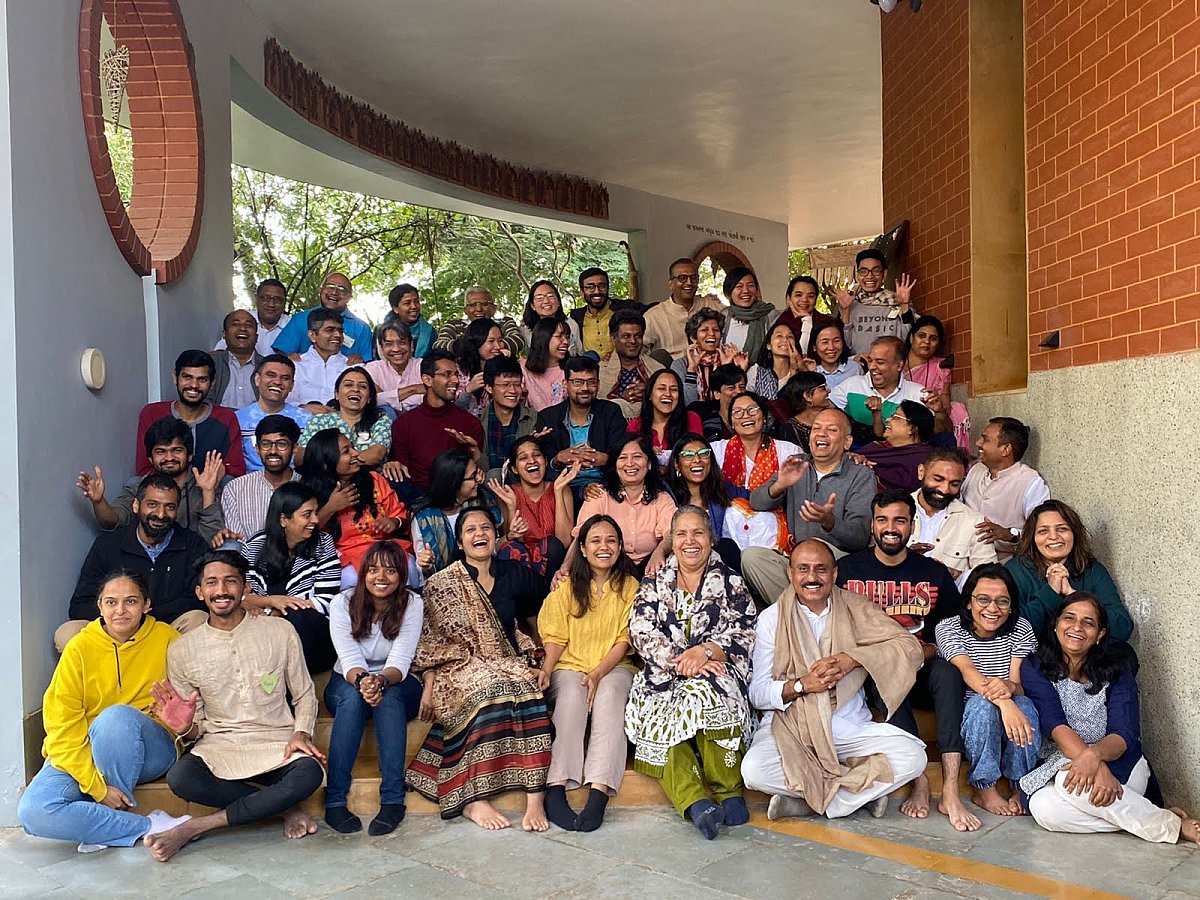Four Days In The Zen Of Action
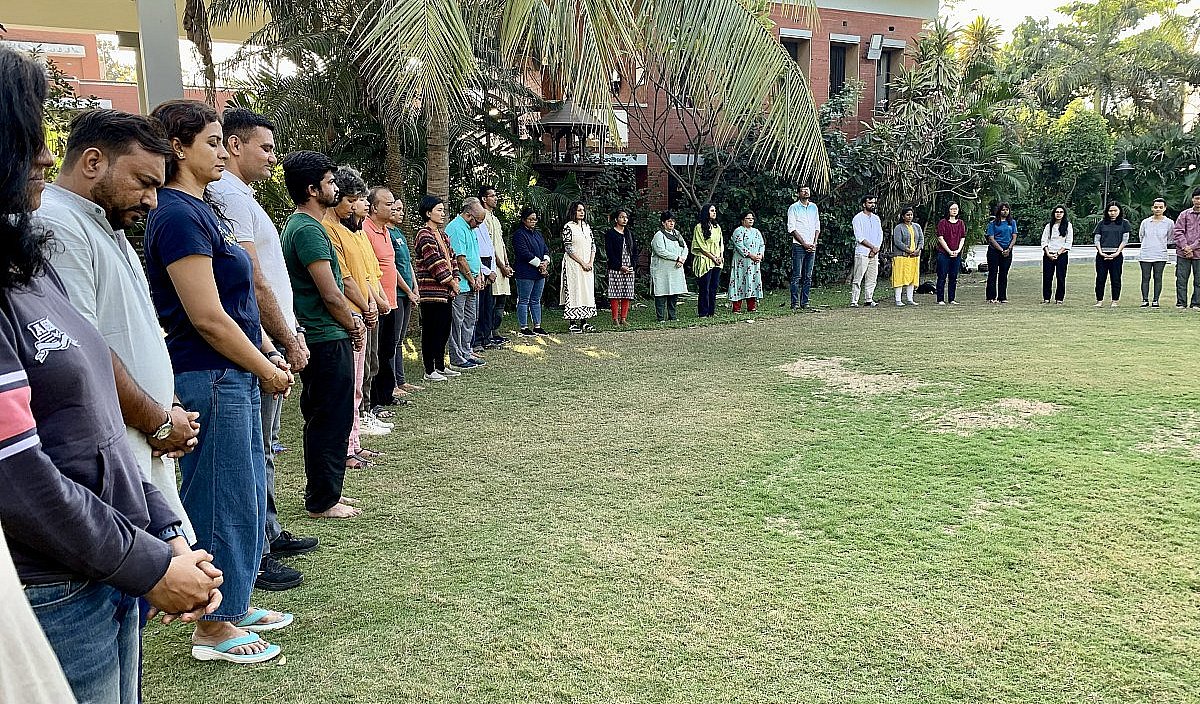
In early December, 55 people across India convened for four days to dive deeper into the nuances of an ancient practice: "Karma Yog". The invitation prompted:
From our very first breath, we are continuously engaged in action. Each has two fields of consequences: external and internal. We often measure ourselves by external outcomes, but it is the subtler inner ripple effect that ends up shaping who we are -- our identity, beliefs, relationships, work and also our contribution to the world. Sages repeatedly warn us that our external impact is only effective if we first tune into its intrinsic potential; that, without an inner orientation, we will simply burn-out by cutting off our supply to the inexhaustible joy of service.
The Bhagvad Gita defines this approach to action as "Karma Yog". In simple terms, it is the art of action. When we dive into that zen of action, with a mind immersed in the joy of the moment and void of any competing desires or expectations for the future, we unlock certain new capacities. Like a hollow flute, the larger rhythms of the universe play its song through us. It changes us, and changes the world.
On the fresh lawn of the retreat campus on the outskirts of Ahmedabad, we began with a silent walk, stilling our minds and taking in the interconnections of the many forms of life in the trees and plants around us. As we convened and took our seats circled in the main hall, we were welcomed by a couple volunteers. After an illuminating parable from Nisha, Parag humorously noted that the nuanced practice of karma yog was humorously noted an aspiration that is a work-in-progress for many of us. He recounted a discussion where the image arose of karma yog as a river flowing, where one end is compassion and the other end is detachment.
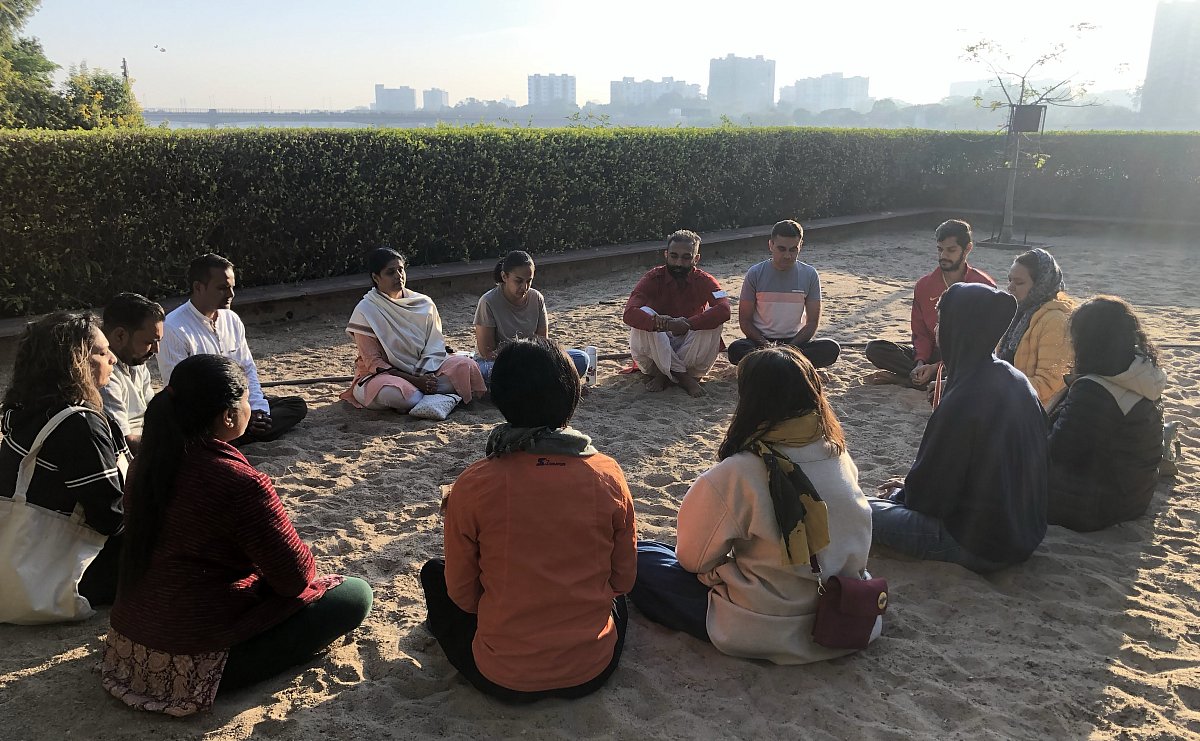
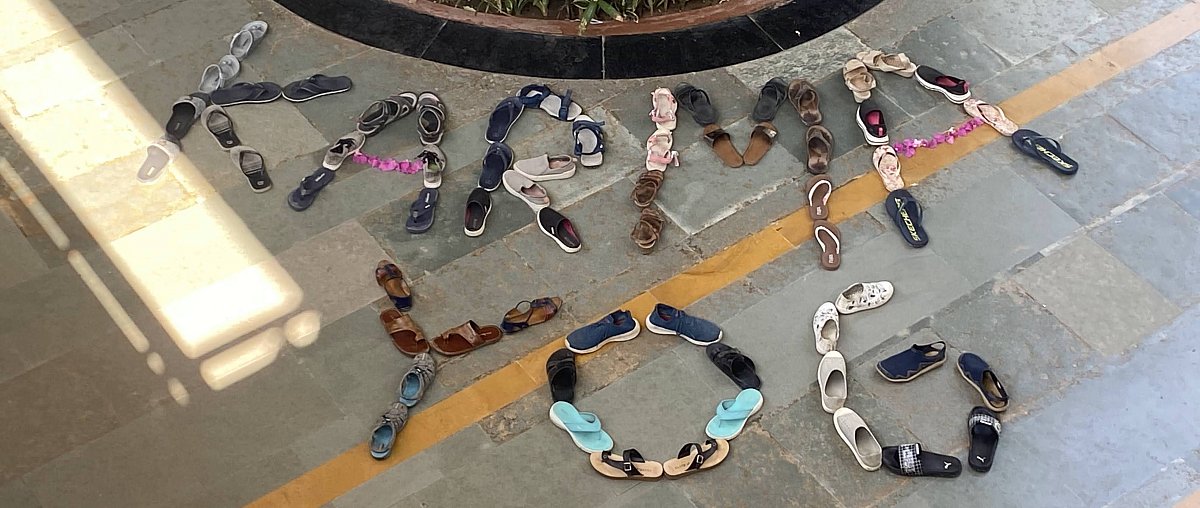

Throughout the four days of our time together, we individually and collectively had the opportunity not only to deepen in an embodied understanding of karma yog, but also to synergize across the lineages of our life journeys, tap into a field of collective wisdom, and ride the ripples of emergence arising from the unique and transitory tapestry of our convergence. Below are some highlights across our shared experience of the hands, head, and heart.
"HANDS"
After an opening evening of various circles, our first morning together witnessed 55 of us dispersed into nine groups across Ahmedabad, where we engaged hands-on practices in service to the local community. Throughout the morning, the activity invited all of us to viscerally explore: How do we optimize our actions, not merely for the immediate impact of “what we do”, but also for the slow and long journey of “who we are becoming” in the process? In the face of suffering, how do we tap into the regenerative flow of compassion? What's the difference between sympathy, empathy, and compassion? And how does our orientation to that distinction influence our capacity for joy and equanimity?
While shadowing the work of rag-pickers, Vy recalled "While walking last week, we saw human manure on the ground. Jayeshbhai gently said, "This person eats well," and then lovingly covered it with sand. Similarly, when looking at waste, we glimpse patterns of our community households -- what we eat and use, and ultimately, how we live." Smita recalled a moment when one woman who works as a rag-picker stated, simply, "I don't need more salary." This prompted the question: When we have so much materially, why are we not satisfied the way this woman is?
Another group cooked a full lunch, enough for 80 people, and offered it to people in a slum neighborhood. "Tyaag Nu Tiffin." After entering a small home where a woman and her paralyzed husband resided on their own, Siddharth M. wondered about the isolation of modern-day. "How can we sensitize our eyes to notice the suffering of others?" Chirag was struck by a woman who, in her prime years, cared for a boy who had no one around to support him. Now she is an elderly lady, yet that young boy cares for her like he would his own mother or grandmother, even though they are not related by blood. What enables us to expand our hearts to give unconditionally, with no exit strategy?
The third group made sandwiches at Seva Cafe, and offered them up to passerby on the streets. Linh observed the regenerative energy of giving to everyone -- regardless of whether they looked like they 'needed' the sandwich. One participant stilled all of our hearts as he described his experience giving a sandwich to a homeless man, and then flashing back to a period in his own life when he himself was homeless for four years, and how the moments when strangers extended a simple kindness to him were indescribable blessings.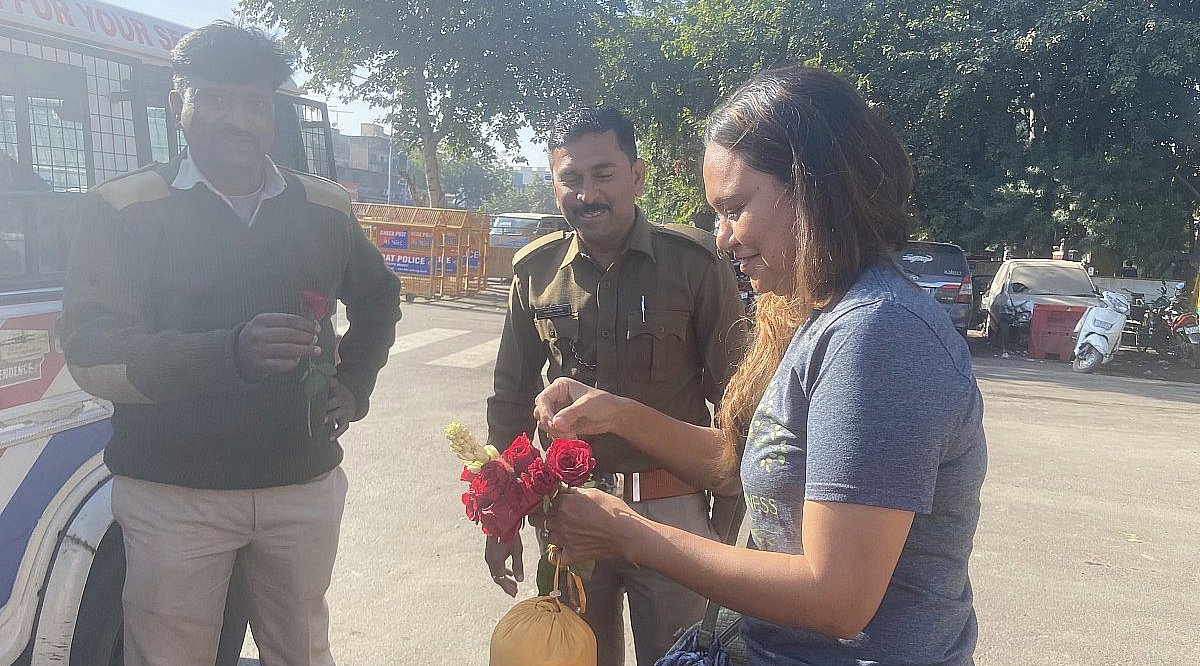
Similarly, a fourth group headed out into the streets of Ahmedabad for a prem parikrama ("pilgrimage of selfless love"). Walking with no money or expectation, what forms of value can arise? Right from the start, a fruit vendor offered the group cheeku fruits despite being informed that they did not have money to pay for it. While the vendor's daily earnings may be a small percentage of the retreat participants who encountered her, the unconditionally with which she gave offered a priceless insight into the deeper kind of wealth that is possible in our ways of living. Along the walk, they encountered a religious celebration that had ended, and along with it, a truckload of flowers that were destined to be trashed. Asking if they could take the flowers, Vivek observed, "someone's garbage is someone else's gift," as they began gifting flowers to bring a smile to strangers along their walk. The spirit of such a process was magnetic. Even police officers on the street asked, "Is there some special event happening? Can we help in some way?" The joy of giving, and zen of action, seems to be contagious. :)
At the local school for the blind, a crew of us were individually blindfolded and given a tour of the school by students who themselves are blind. Neeti was led by a young girl who brought her to the library, and put a book in her hand. "This is a Gujarati book," she definitively said. Taking other books from the shelf, "This one is in Sanskrit. And this one is in English." Unable to see the books, Neeti wondered, 'Who is the one who is actually visually impaired? It seems to be me.'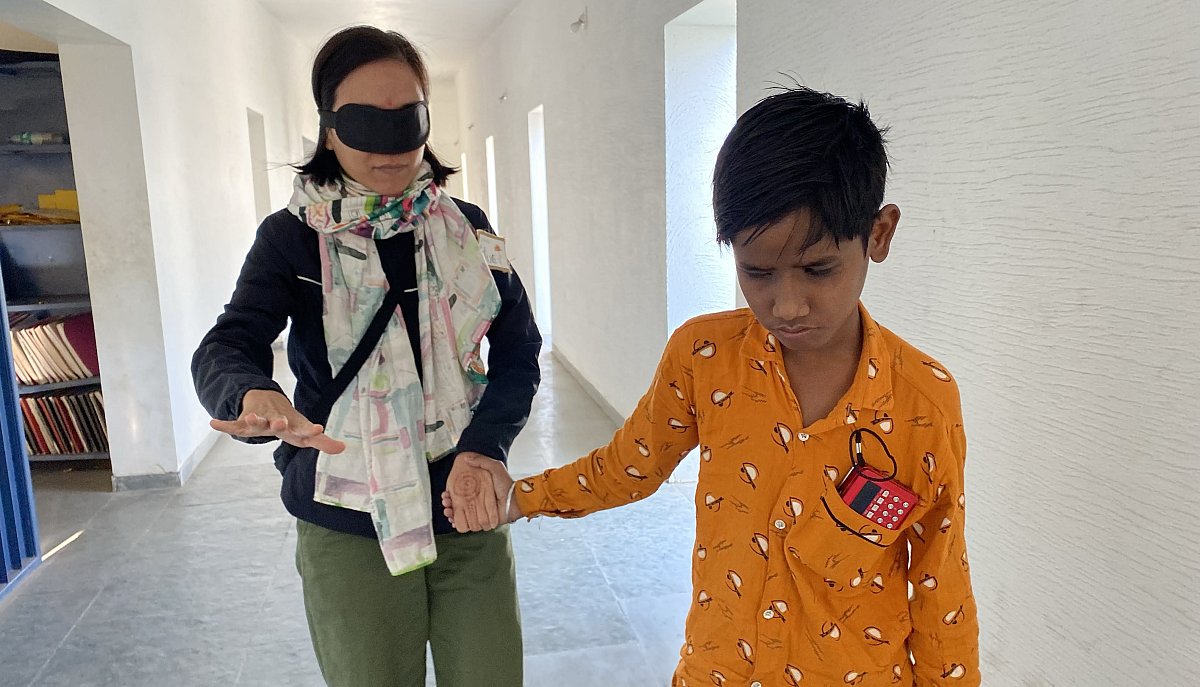
Other groups engaged with community in a nearby ashram, a workshop for a wide range of traditional artisans and designers, a vocational school for young people with mental disabilities, and a village of shepherds. While artfully arranging tiles in a garden at the nearby ashram, Siddharth K. noticed, "Broken tiles were easier to place in the design than those that were flawlessly full and unblemished." It's like that in life, too. The cracks in our lives and hearts create the conditions for a deeper resilience and capacity to hold the beautiful complexity of our shared human journey. All throughout a symphony of action and stillness pervaded the air, as each one of us harmonized our individual frequency to the orchestra of hearts opening, synchronizing, and pointing towards our deeper interconnections -- where we are not the doers of our actions, but simply a flute through which the winds of compassion can flow through.
"HEAD"
"When our fear touches one's pain, we feel pity. When our love touches one's pain, we feel compassion."
After a spirited half-day of hands-on experiential action, we reconvened in the Maitri Hall, where Nipun offered up insights that nurtured the brew of our collective intelligence. From a non-linear process of transaction to relationship to trust to transformation, inputs from John Prendergast's four stages of being grounded, three shifts from sensing to embracing to trusting the flow, and a 'me to we to us' spectrum of relating -- the gears of 55 minds and hearts were clicking and turning in concert across the room.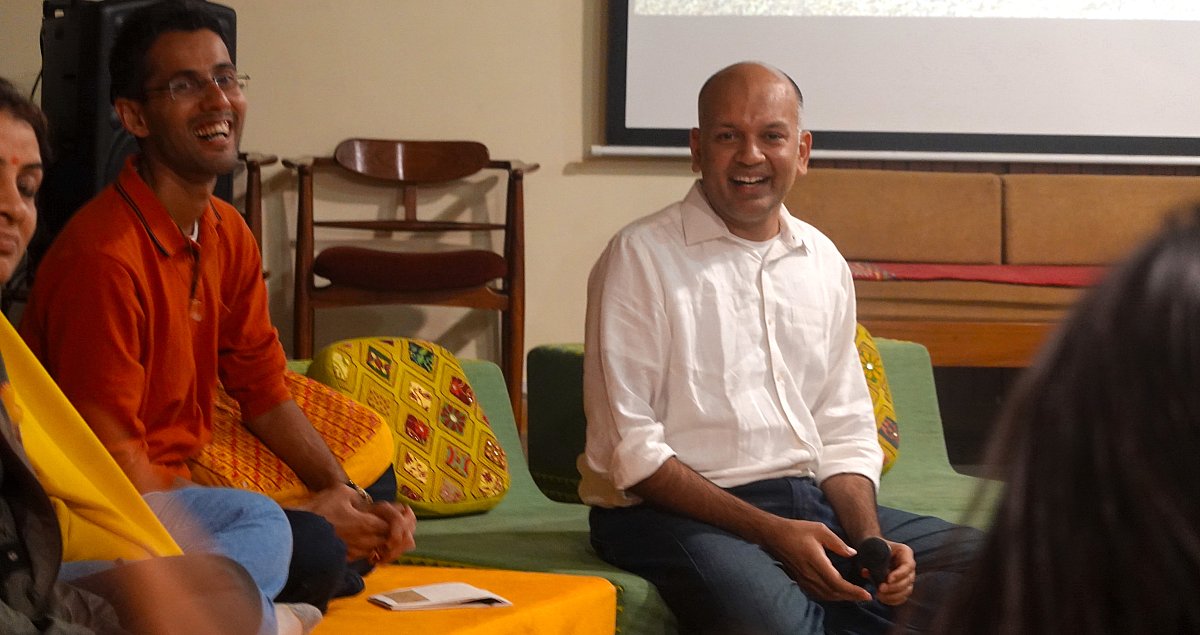
A few highlights from the thoughtful conversation that ensued include ...
How do we harmonize individual and collective flow? Vipul pointed out that individual flow is easier for him than tuning into the collective flow. How do we engage collectively? Yogesh wondered how to draw skillful boundaries. How do we engage in ways that optimize for the affinity to universal values that draw us all together, rather than relating on 'me' and 'we' levels of individual personalities or group preferences?
How much of flow is effort vs surrender? Swara reflected, "What enables sahaj ('effortlessness')? What makes things flow naturally?" It takes hard work to make many efforts possible; yet the outcomes are often a result of myriad factors. In karma yog, we give our best effort, yet also detach from results. Gandhi famously said, "renounce and enjoy." It was not "enjoy and renounce". Srishti pointed out that renouncing something before we have the capacity to fully renounce it can backfire as deprivation. As we navigate "what is mine to do," we can take small steps along the way. "I may aspire to make 30 sandwiches to share with strangers, but I can start by making one sandwich for my neighbor." How do we balance between effort and effortlessness?
As we serve, what qualities foster inner sustainability and regenerative joy? "Can we maintain the body the way we'd service a car?" one person asked. "A body is like an antenna. The question to ask would be how do I re-sensitize the body so I can tune in?" another reflected. Siddharth added, "Judgment puts a lid on emergence." Beyond the known and unknown is the unknowable, which the ego finds uncomfortable. How do we "soften our gaze" and discern which thoughts or inputs from our senses are actually in service to ourselves and the greater good? Darshana-ben, who works as a gynecologist, pointed out, "No medical school is going to help me understand how a baby is created. Similarly, no one can say who put the water inside a coconut, or who put fragrance in a flower." In a similar spirit, Yashodhara spontaneously offered a prayer and poem that included the line: "To be hopeful means to be uncertain about the future ... to be tender to possibilities."
With all this in mind, the next morning, we flowed into dynamic discussions around the edges and spectrums we're holding around principles of karma yog. From that space, we dispersed into small group discussions around a dozen questions (that some invisible elves displayed in a gorgeous deck):
Inner & Outer Change: I like the idea of focusing on inner transformation. At the same time, I also strive to maximize my contribution and impact to society. How can we cultivate a better balance between inner and outer change?
Emergency & Emergence: When many in society struggle with urgent physical needs, then designing for spiritual transformation feels like a luxury. How do we discover the right balance between emergency and emergence?
Conviction & Humility: All actions have an intended impact but also unintended consequences. Sometimes the unintended consequences can be slow, invisible and much harder to reverse. How to balance conviction with humility and reduce the unintended footprint of our actions?
Grit & Surrender: The harder I work on something, the more difficult it feels to be detached from outcomes. How do we balance grit with surrender?
Purity & Practicality: In today’s world, ethical short-cuts sometimes feel like a practical necessity. Is it sometimes justified to compromise on a principle if it supports a greater good?
Unconditionality & Boundaries: When I show up unconditionally, people tend to take advantage. How do we create a better balance between inclusion and boundaries?
Individual & Collective Flow: I want to be authentic to my inner voice, but I also want to be led by the wisdom of the collective. What helps align our individual flow with the collective flow?
Suffering & Joy: As I engage with suffering in the world, sometimes I feel exhausted. How can we cultivate more joy in service?
Tracking & Trust: It is easy to measure external impact, while it is much harder to measure inner transformation. Without quantifiable milestones, how do we know if we are on the right track?
Service & Sustenance: If I give without seeking anything in return, how will I sustain myself?
Responsibilities & Cultivation: I need to take care of my family and other responsibilities. I struggle to make time for spiritual cultivation in my daily routine. How do we balance responsibilities with cultivation?
Profits & Love: I run a for-profit business. I am wondering if it’s possible to engage in transactions with a heart of karma yogi?
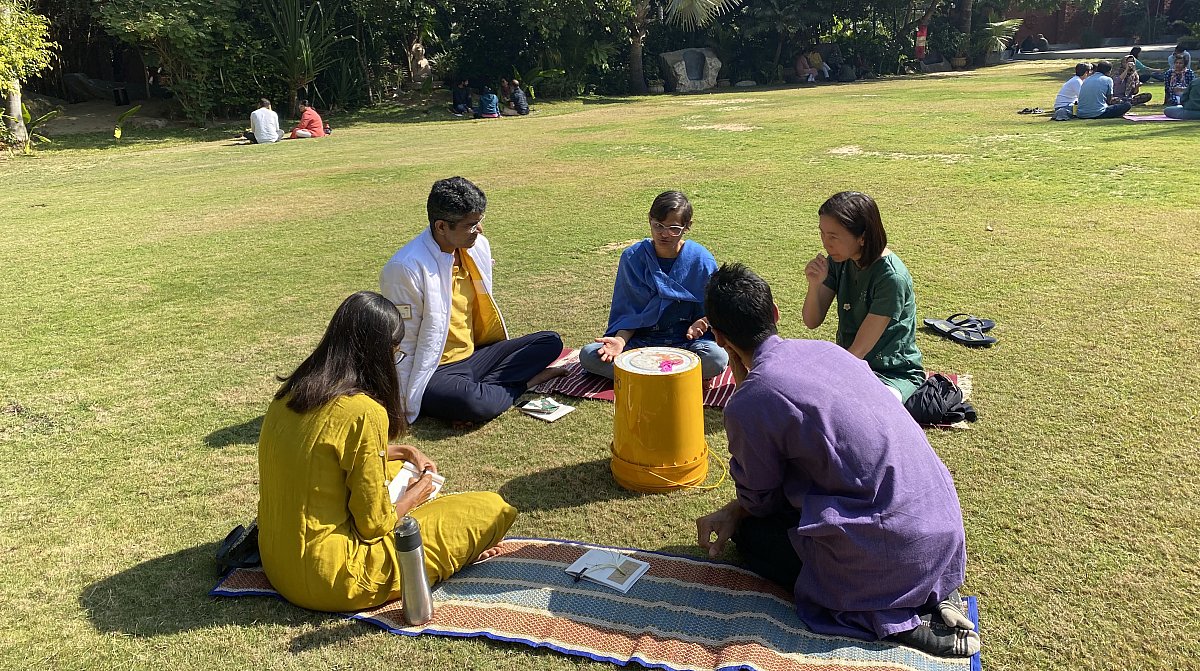
After spirited conversations flew by, we heard a few highlights from the collective. Loan wondered "How do we cultivate a balance of inner and outer change?" She noted the ego wants to create a big impact and make a large change in society, but how can we ensure our service mirrors the inner transformation in the process? Srishti remarked on the significance of the inner shift from a mindset of "Do what you love" to "Love what you do" to, simply, "Do what you do." Brinda pointed out that one of her metrics for inner growth is how quickly she gets out of the mind's spiraling thoughts when an effort backfires or triggers unintended consequences.
"HEART"
Throughout the gathering, the sanctity of everyone's attentive presence allowed blossoms of the heart to unravel, expand, and blend into one another, harmonizing to each other's frequencies -- all of which give rise to unpredictable possibilities. From our first evening together, our collective group flowed into an organic configuration of small, distributed circles of sharing in the format of a 'World Cafe'.
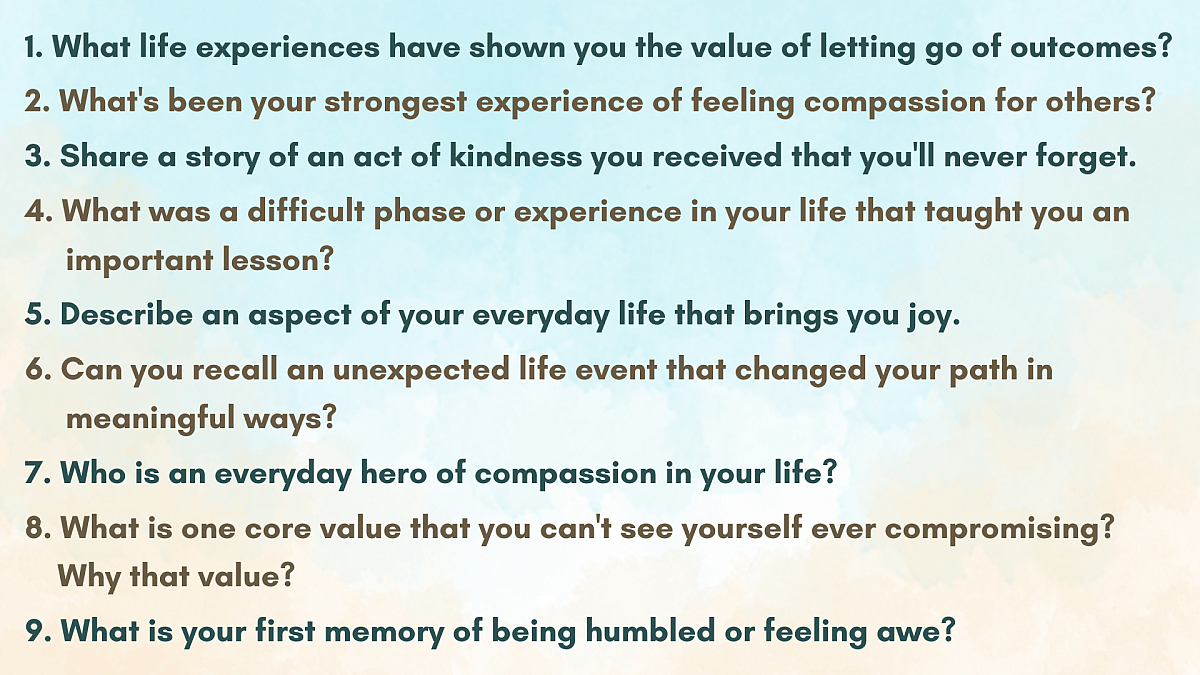
After each of us delved into temporal groups exploring four out of a dozen questions, Siddharth M. noted, "Questions are the key to the heart. After these circles, I realised that the key I was holding before was wrong. :) Asking the right kinds of questions is the key to seeing the goodness and humanity in everyone." Similarly, Vivek observed how stories surface more stories. "Originally, I didn't think I had anything to share in response to the questions, but as others began sharing their stories, related memories and reflections from my own life flowed into my mind." We then got a real-time demonstration of this as one woman shared how someone in one of her small circles spoke about a difficult relationship with her father; and simply listening to that story inspired her to resolve to speak with her own father. Another young woman in the circle raised her hand to share next: "Inspired by what you said, I'm also going to check up on my own father." Siddharth S. echoed, "My story is in everyone".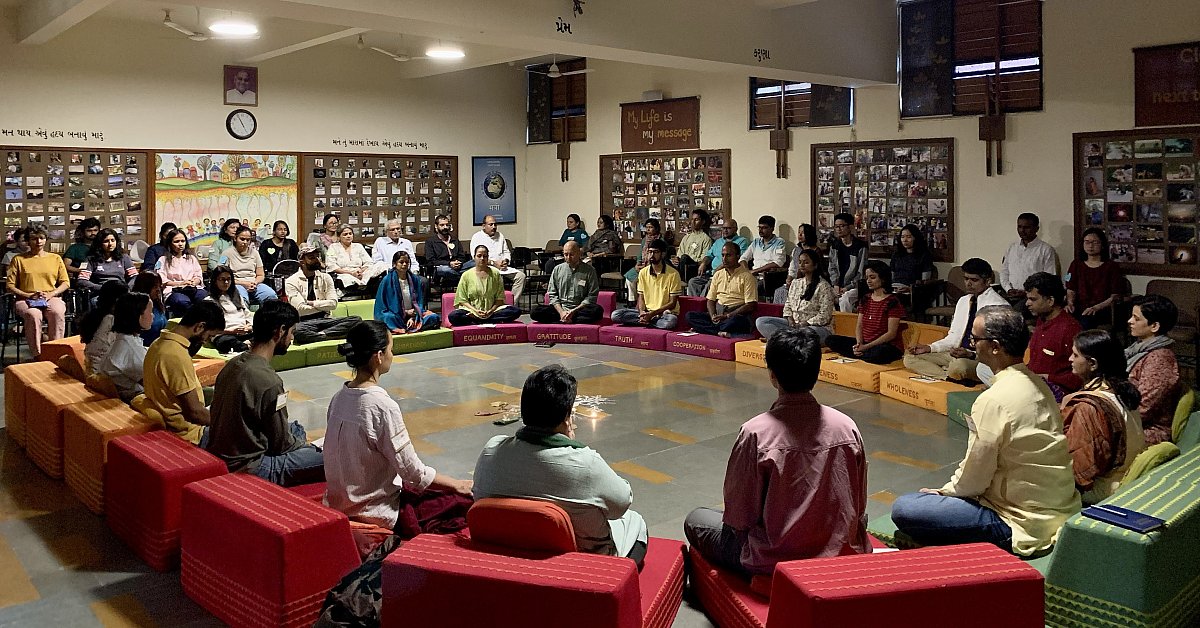
Along that thread of shared stories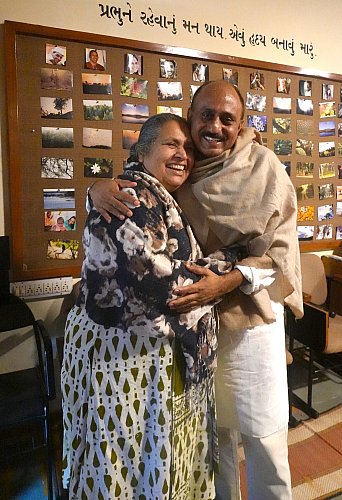 , one evening invited us to catch glimpses of the stirring journey of an embodiment of karma yog -- Sister Lucy. Lovingly nicknamed the "Mother Teresa of Pune," decades ago, a traumatic accident propelled her to start a home for destitute women and children. While she simply wished to provide shelter for twenty or so women and their children, today that intention has mushroomed into 66 homes for thousands of destitute women, children, and men across India. With an eight grade education, she has nurtured the lives of thousands, and been honored by the president of India, the Pope, even Bill Clinton. Just giving Sister Lucy a hug is like embracing the love in her heart, the strength in her presence, the fierce simplicity of her intentions, and the brightness of her joy. When she shares stories, many of them are real-time occurrences. Just the day before, some of her children skipped school to go to a lake, and one almost drowned. "I can laugh now, but I wasn't laughing then," she noted as she recounted their very human incident of mischief, firm forgiveness, and motherly love. In response to her remarkable stories, Anidruddha asked, "How do you cultivate joy?" The lightness with which she holds the chaos of being a mother to thousands of children, the bureaucracy of running a national NGO, the trauma of poverty and domestic violence, the mischievous adventures of energetic children, inevitable staff challenges, and beyond, is awe-inspiring to behold. Sister Lucy just replied, "If you take children's mistakes as a joke, you won't burnout. I tell my staff, 'Can you smile at a problem?'" After 25 years of running her NGO, Maher, no child has ever been sent back.
, one evening invited us to catch glimpses of the stirring journey of an embodiment of karma yog -- Sister Lucy. Lovingly nicknamed the "Mother Teresa of Pune," decades ago, a traumatic accident propelled her to start a home for destitute women and children. While she simply wished to provide shelter for twenty or so women and their children, today that intention has mushroomed into 66 homes for thousands of destitute women, children, and men across India. With an eight grade education, she has nurtured the lives of thousands, and been honored by the president of India, the Pope, even Bill Clinton. Just giving Sister Lucy a hug is like embracing the love in her heart, the strength in her presence, the fierce simplicity of her intentions, and the brightness of her joy. When she shares stories, many of them are real-time occurrences. Just the day before, some of her children skipped school to go to a lake, and one almost drowned. "I can laugh now, but I wasn't laughing then," she noted as she recounted their very human incident of mischief, firm forgiveness, and motherly love. In response to her remarkable stories, Anidruddha asked, "How do you cultivate joy?" The lightness with which she holds the chaos of being a mother to thousands of children, the bureaucracy of running a national NGO, the trauma of poverty and domestic violence, the mischievous adventures of energetic children, inevitable staff challenges, and beyond, is awe-inspiring to behold. Sister Lucy just replied, "If you take children's mistakes as a joke, you won't burnout. I tell my staff, 'Can you smile at a problem?'" After 25 years of running her NGO, Maher, no child has ever been sent back.
Another evening, remarkable stories and songs flowed across our Maitri Hall. Linh soulfully presenced the spirit of a Gandhian sculptor through his song lyrics: "Game, game, game. Life is a game."
Dhwani reflected on the experience of a walking pilgrimage on the Narmada River, where she realised, "If I just have the ability to breathe, I can be in service." Siddharth M. recounted an experience during the pandemic where he worked to bridge produce from farmers to people in the city, when everything was closed down due to covid. When he asked the farmers how much to charge for the vegetables, they humbly replied, "Just have them pay what they can. Tell them where the food comes from and the effort that goes into it." Sure enough, the grateful city-dwellers offered monetary sustenance for the food, and seeing this pay-it-forward experience play out in front of his eyes, Siddharth wondered, 'How can I integrate this in my business?' The answer that came was a new experiment -- he invited longtime staff at his company to decide their own salary.
All throughout our four days, streams of offerings flowed from one to the next. A gift of cheeku fruits from a fruit vendor turned up as a bonus snack in that day's lunch. A farmer based hundreds of kilometers from the retreat center sent a sack of flowers for the last day's ambiance, just to contribute to the spirit of the retreat. In one of the group sessions, Tu shared about unexpectedly being gifted beautiful offerings from Craftroots artisans. While at first struggling and resisting such a gift, she reflected, "If we reject a sincere gift, then someone's good intention cannot flow." During the palpable beauty of a silent dinner, Tuyen was the last to finish eating. While everyone already had gotten up from the eating area, one person at a distance sat with him until he finished. "It's nice to have someone with you when eating dinner," she later told him. Often at the end of meals, there were humorous "fights" to do each other's dishes. Such playful joy stayed with all of us, and on the last day, Ankit echoed a simple sentiment shared by many: "I'll do the dishes at home."
One evening, Monica offered up a poem she spontaneously wrote about our time together. Here's a few lines from it:
And with willing hands of ours we built
tall bridges from one heart to heart
with souls that seemed so pulled by love
from all the corners of the world
to be here now so moved by love
to open up our many hearts,
and pour in some and pour out love.
As love poured forth in small trickles and tidal waves, Jesal shared an apt parable: "When the Buddha asked one of his disciples to fill water in a leaky bucket and bring it to him, the disciple was perplexed. After doing it a few times, he realised the bucket had become cleaner in the process."
With gratitude for such a "cleaning" process, at the end of the gathering, we circumnavigated the retreat center bowing our heads, hands, and hearts to the inexplicable emergence that had transpired. While karma yog may still be an aspiration from ancient scriptures, convening together around such shared intentions enabled us to fill and empty our buckets again and again, each time returning a little emptier and more whole in the process.